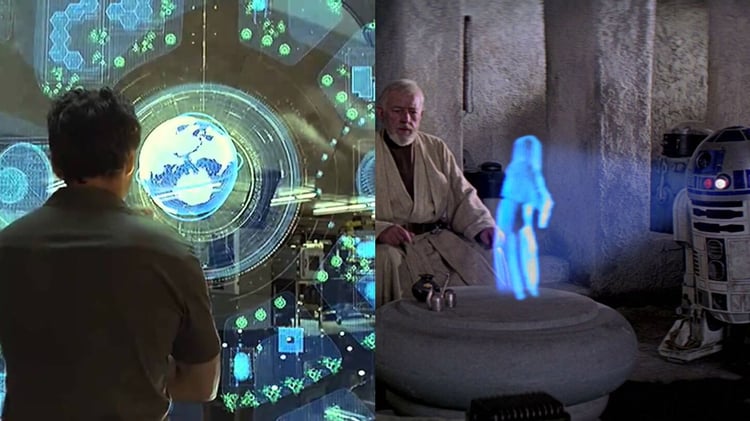In a recent and very thoughtful interview on Sixteen by Nine, the author David Haynes interviews Daniel Smalley, an associate professor of electrical engineering at Brigham Young University, and together they explore the growing trend by marketers to classify their LED fans, transparent light boxes and micro lens solutions as “Holographic Displays”.
Smalley explains that while there are currently products on the market that claim to be holograms, they do not meet the true definition of holography. He discusses the three families of displays - ray displays, wave displays, and point displays - and explains that true holography involves superimposing multiple surfaces to build up an image in mid-air, creating optically indistinguishable images from real objects.
Holography, the science and art of creating three-dimensional images, has long captured the imagination of science fiction enthusiasts and technologists alike. From the iconic holographic communications in "Star Wars" to the holographic displays in "Iron Man," holograms have been portrayed as futuristic and immersive displays that could revolutionize the way we interact with digital content.

However, bandwidth and computational power remain significant challenges in achieving true large-scale holographic displays which is why Smalley opines that We’ll Colonize Mars Before We See Displays That Really Are Holograms.
It was incredibly insightful and we didn’t want to miss the chance to share these distinctions with our audience to help demystify the subject and add our comments.
Introduction
Holograms have been a popular concept in science fiction for decades. However, in spite of recent advancements in display technology, true holograms as depicted in science fiction are still a distant reality.
One of the reasons why “holograms” frustrate Smalley is the misuse of the very term in marketing. Many products claim to have holographic displays, but they do not meet the true definition of holography – not even close!. For example, some displays are labeled as "holographic" but are actually just 2D transparent displays in large light box, or a spinning fan that uses persistence of vision to make images appear to float - albeit loudly and with a flicker - in 2D space. These systems are not holographic in any way.
As Smalley points out, true holography involves shaping light using diffraction patterns to create a wavefront that can be focused at different points to build up a 3D image in mid-air – imagine lasers that can terminate where you want on command. This, of course, is much easier to do in movies than in real life.
However, there are systems that create depth perception and produce quasi “holographic” effects to the viewer such as the Glasses-Free 3D displays made by Magnetic 3D.
They use lenticular lenses to crisscross rays of light – the content - providing the viewer with distinct perspectives to each eye that elicit real depth perception. Also referred to as Autostereoscopic displays, these Ray displays are versatile, cost-effective and adept at producing a number of different effects from pseudo holograms to Pepper’s Ghost even if they aren’t technically using “diffraction-based” physics.
A company claiming to have both a Holographic and a Light Field Display is Looking Glass. Smalley points out that Looking Glass is neither and would be considered a ray display. Instead of creating 3D depth perception, the product uses cylindrical lenses to create a parallax effect when viewed from different angles. When you move left and right, you can see the image change perspective, but when you move up and down, you don't see the same effect. The Looking Glass display has limitations in terms of the resolution and realism of the 3D image it produces, which - according to the article - can leave viewers underwhelmed.
The Challenges of Bandwidth and Computing Power are the main issue. According to Smalley, while it is possible to create small holographic video displays, the sheer amount of computational power and bandwidth required to feed a large holographic display with all the pixels it needs remains a significant obstacle. Let’s again reference his estimation that we might “colonize Mars” before we have the capacity to easily create large holographic displays.
Practical Applications of Holograms
While true holograms as depicted in science fiction are still a work in progress, there are already practical applications for quasi-holograms. Smalley mentions that holography has been used in areas such as medical imaging, where holographic displays can provide 3D visualizations of complex anatomical structures. Holography also has potential applications in areas like teleconferencing, virtual reality, and entertainment, where realistic 3D images can enhance user experiences. Despite the challenges and limitations, holography continues to be an active area of research with promising future possibilities, but the real thing might be decades away.
In conclusion - while the term "hologram" is often misused in marketing, true holograms as depicted in science fiction are still a technological challenge. The limitations of bandwidth and computing power, as well as the complexities of shaping light using diffraction, make achieving large holographic displays a significant obstacle. In other words, don’t expect to see Jaws attacking people in Times Square anytime soon.

However, creating holographic effects today is possible - lenticular displays provide a convincing effect without glasses and a price that won’t break the bank. Based on Smalley’s prediction, it seems that Glasses-Free 3D Displays will make it to Mars first to support Elon Musk’s colonization efforts there long before we see science fiction-like holograms become a reality!
About Magnetic 3D:
Headquartered in New York City, Magnetic 3D enables greater access to the world’s 3D content and the metaverse with an industry-leading, end-to-end product line of Glasses-Free 3D (autostereoscopic) solutions ranging from 3D mobile devices and desktop monitors to 100” 3D Displays in Landscape and Portrait format, as well as 3D Video Walls up to 275”.
The Company’s proprietary platform of modified LCD displays features a precision engineered, optically-bonded 3D lens and custom electronics which enable 3D video capabilities without the need for 3D Glasses or VR/AR headgear. The visual experience provides audiences with captivating off-screen “pop”, akin to holographic effects depicted in science fictions films, and the immersive perception of depth on what would otherwise be a flat display.
Magnetic 3D provides the highest-quality Glasses-Free 3D visual experience for B2B applications across verticals such as retail, digital signage, gaming, digital-out-of-home advertising, Pro AV, Smart City, IOT, hospitality, movie theaters, casinos, hotels and entertainment venues. The Company also provides visualization solutions and consulting services for aerospace, medical and defense applications where depth perception is required. The company is actively adding NFT integration and creator tools to enable next-generation visual artwork for B2B and B2C applications.
Website:
Instagram:
https://www.instagram.com/magnetic3d/
Twitter:
https://twitter.com/magnetic3d
YouTube:




